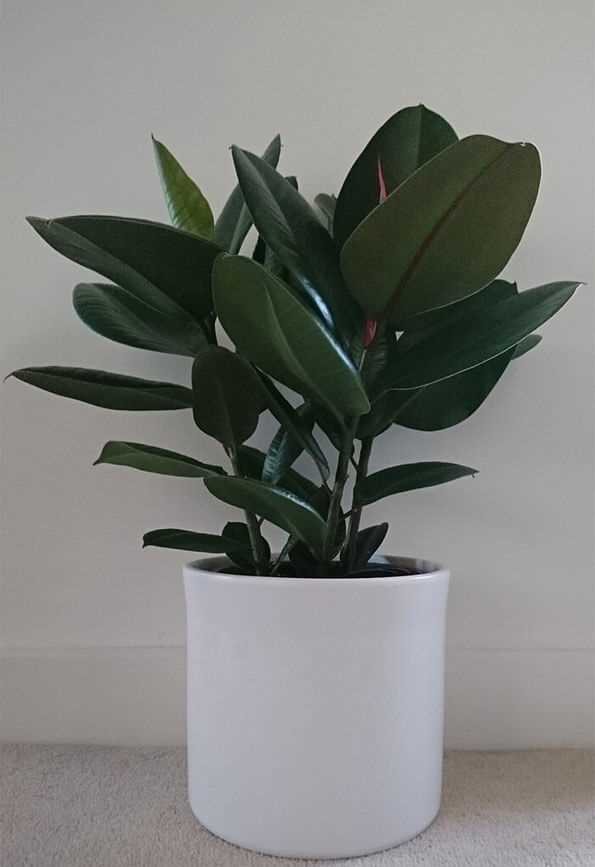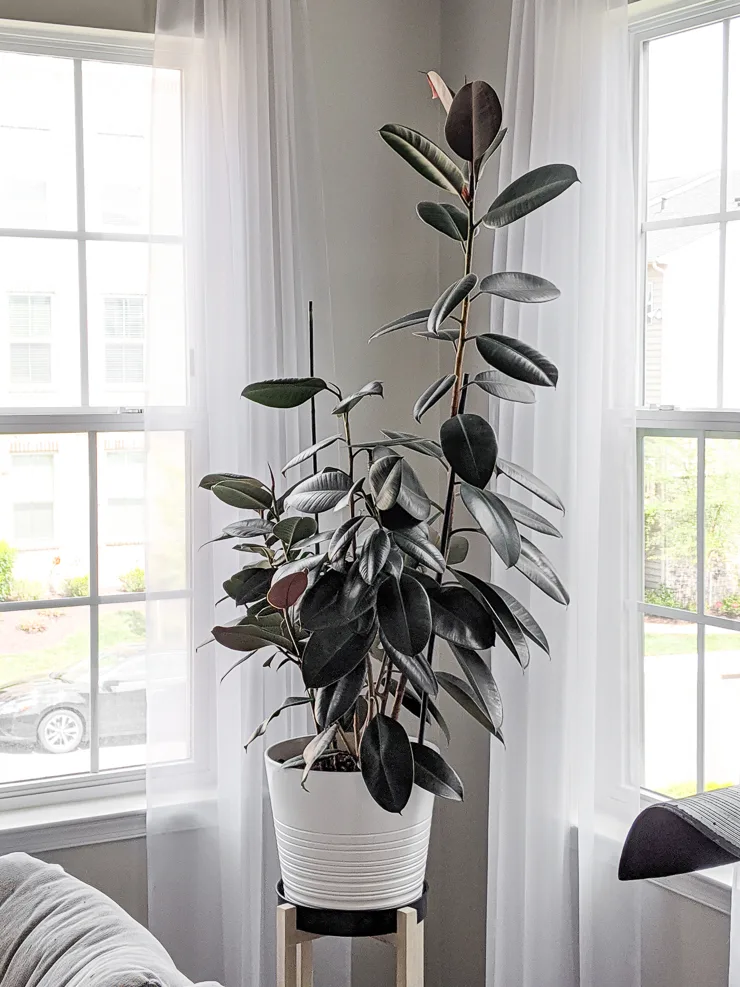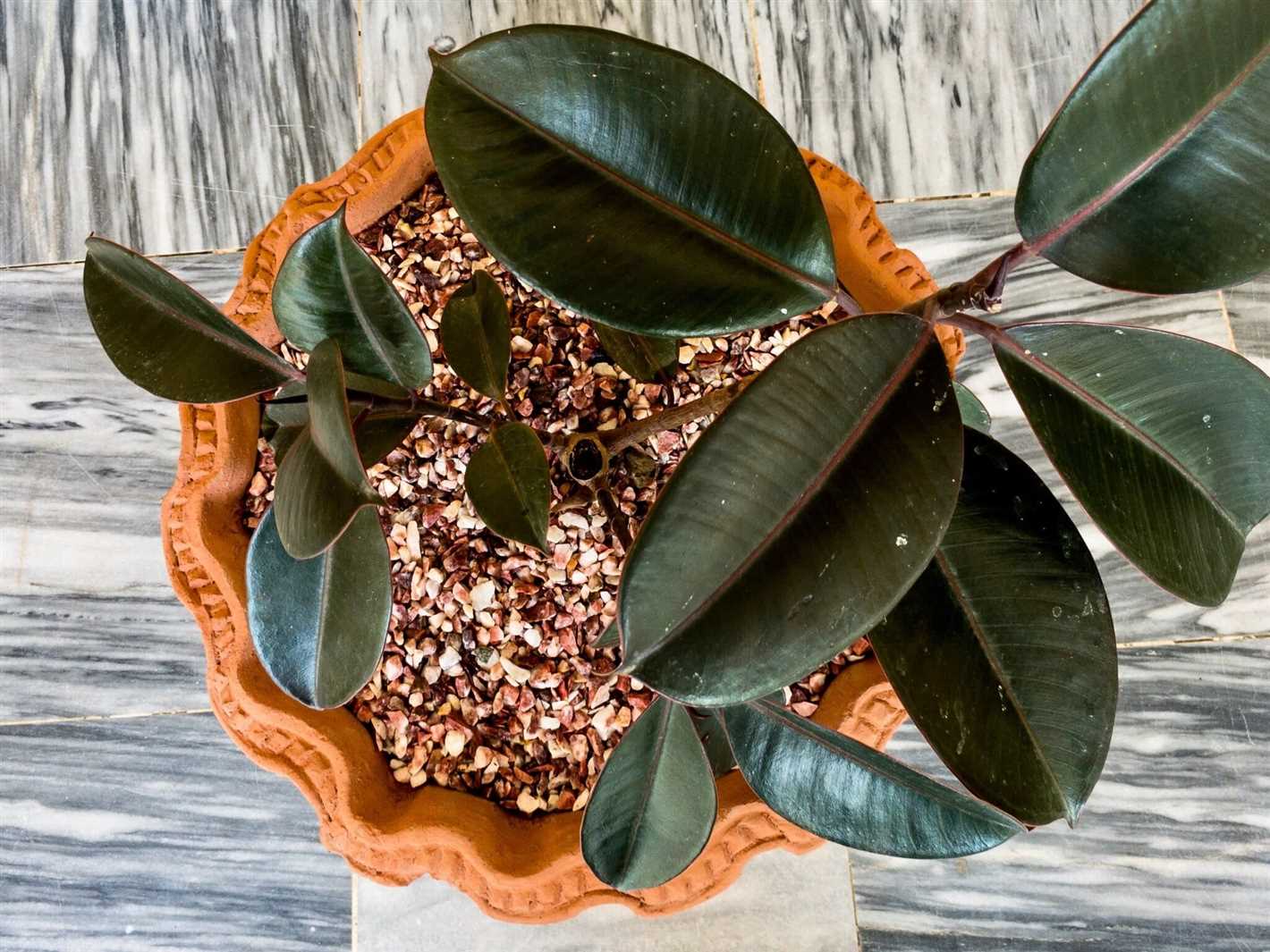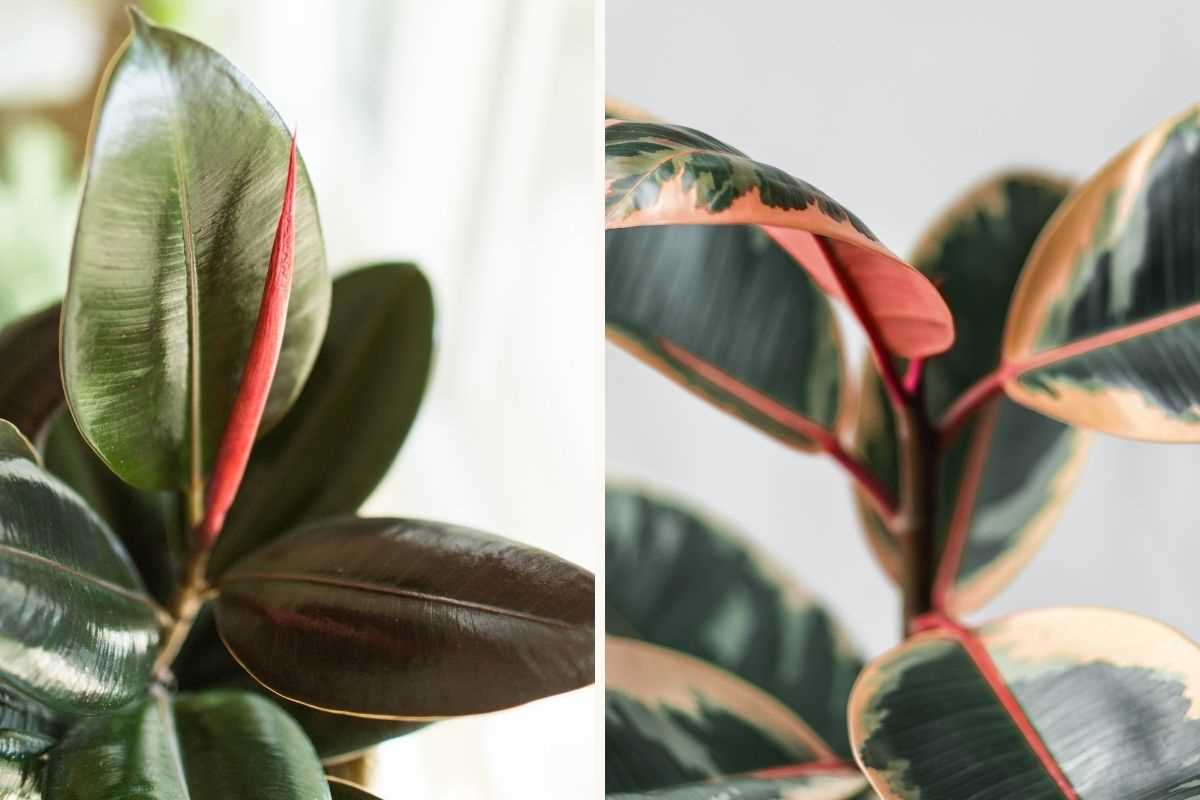- Ficus Rubber-Leaved Ficus: Care at Home
- Introduction
- Lighting
- Watering
- Temperature
- Humidity
- Soil
- Fertilizer
- Pruning
- Pests
- Conclusion
- Choosing the Right Location for Your Ficus Rubber-Leaved Ficus
- Selecting the Appropriate Pot and Soil
- Pot Selection
- Soil Selection
- Transplanting
- Watering Your Ficus Rubber-Leaved Ficus
- 1. Understand the watering needs of your ficus rubber-leaved ficus
- 2. Check the moisture level of the soil
- 3. Water your ficus rubber-leaved ficus thoroughly
- 4. Allow excess water to drain
- 5. Don’t let your ficus rubber-leaved ficus sit in wet soil
- 6. Adjust watering frequency based on environmental conditions
- 7. Use room temperature water
- 8. Consider using a moisture meter
- 9. Observe your plant
- Providing Adequate Lighting
- 1. Natural Light
- 2. Artificial Light
- 3. Light Duration
- 4. Light Intensity
- Temperature and Humidity Requirements
- Fertilizing Your Ficus Rubber-Leaved Ficus
- 1. Choose the right fertilizer
- 2. Follow the recommended dosage
- 3. Feed during the growing season
- 4. Water before fertilizing
- 5. Avoid foliar feeding
- 6. Keep an eye on the plant’s response
- Pruning and Shaping
- Why prune your rubber-leaved ficus?
- When to prune?
- How to prune?
- Aftercare
- Regular maintenance
- Common Problems and Solutions
- Pests
- Overwatering
- Insufficient Light
- Incorrect Temperature
- Nutrient Deficiencies
- Q&A:
- How often should I water my rubber-leaved ficus?
- What is the ideal temperature for rubber-leaved ficus?
- How much light does a rubber-leaved ficus need?
- What kind of soil is best for rubber-leaved ficus?
- How often should I fertilize my rubber-leaved ficus?
- Video: 7 Simple Tips For A Super Bushy Rubber Plant
If you’re looking for a low-maintenance plant that can bring a touch of nature into your home, the ficus rubber-leaved ficus might be the perfect choice for you. With its glossy leaves and easy care requirements, this plant is a popular choice among indoor gardeners. Whether you’re a beginner or an experienced plant enthusiast, this article will provide you with expert tips and advice on how to care for your ficus rubber-leaved ficus.
One of the key things to keep in mind when caring for a ficus rubber-leaved ficus is its light requirements. This plant thrives in bright, indirect light. Too much direct sunlight can scorch its leaves, while too little light can cause its foliage to become sparse. It’s best to place your ficus in a well-lit area, away from direct sunlight. However, if you notice that your plant’s leaves are turning yellow, it may be a sign that it’s not receiving enough light.
In addition to light, the ficus rubber-leaved ficus also has specific watering needs. It’s important to allow the top inch of soil to dry out before watering your plant. Overwatering can lead to root rot, so it’s important to strike the right balance. When watering, pour water into the soil until it drains out of the bottom of the pot. This ensures that the roots receive adequate moisture without becoming waterlogged. You should also avoid letting your ficus sit in standing water, as this can lead to root rot as well.
Another important aspect of ficus rubber-leaved ficus care is humidity. This plant thrives in humid conditions, so it’s a good idea to mist its leaves regularly. You can also place a tray of water near your plant to help increase humidity. However, be mindful not to place the plant too close to a heating or cooling vent, as this can cause the air to become too dry.
By following these expert tips and advice, you can ensure that your ficus rubber-leaved ficus thrives in your home. With its beautiful glossy leaves and easy care requirements, this plant is sure to bring a touch of nature and greenery into your living space.
Ficus Rubber-Leaved Ficus: Care at Home
Introduction
The ficus rubber-leaved ficus, also known as Ficus elastica, is a popular houseplant that is loved for its lush, glossy leaves and easy care requirements. In this article, we will provide expert tips and advice on how to care for your rubber-leaved ficus at home.
Lighting
The rubber-leaved ficus thrives in bright, indirect light. It can tolerate some direct sunlight, but too much can scorch the leaves. Place your rubber-leaved ficus near a east or west-facing window where it can receive bright, filtered light throughout the day.
Watering
This ficus prefers regular watering, but it is important to avoid overwatering. Allow the top inch of soil to dry out before watering again. Water thoroughly until water drains out from the bottom of the pot. In winter, reduce watering frequency to prevent waterlogged soil.
Temperature

The rubber-leaved ficus prefers temperatures between 60-75°F (15-24°C). Avoid placing it near drafty windows or doors, as cold drafts can be harmful to the plant. The ficus can tolerate slightly lower temperatures during winter, but it should not be exposed to frost or extreme cold.
Humidity
This ficus enjoys high humidity. To increase humidity, you can mist the leaves regularly or place a tray filled with water near the plant. Grouping plants together can also help to create a more humid microclimate. Avoid placing it near heating vents or air conditioners that can dry out the air.
Soil
A well-draining soil mix is ideal for rubber-leaved ficus. A mixture of peat moss, perlite, and regular potting soil can provide good drainage while retaining moisture. Avoid using heavy, compacted soils that can retain excess moisture and lead to root rot.
Fertilizer
During the growing season (spring and summer), feed your rubber-leaved ficus with a balanced liquid fertilizer every 2-4 weeks. Dilute the fertilizer to half the recommended strength to avoid overfeeding. In winter, reduce the frequency of fertilization to once every 6-8 weeks.
Pruning
Pruning is not necessary for the rubber-leaved ficus unless you want to control its size or shape. If you decide to prune, do so in early spring before new growth begins. Use clean, sharp pruning shears to remove any dead, damaged, or overgrown branches.
Pests
Common pests that can affect the rubber-leaved ficus include aphids, mealybugs, and spider mites. Regularly inspect the plant for any signs of infestation, such as sticky residue, webbing, or distorted leaves. Treat infestations with an appropriate insecticide or by wiping the leaves with a mixture of mild soap and water.
Conclusion
With the right care, a rubber-leaved ficus can be a beautiful addition to your indoor plant collection. Remember to provide it with the right lighting, water it properly, maintain humidity, and keep an eye out for pests. Enjoy the beauty and elegance that this wonderful plant brings to your home.
Choosing the Right Location for Your Ficus Rubber-Leaved Ficus
Proper placement of your ficus rubber-leaved ficus is essential for its growth and overall health. Consider the following factors when choosing the right location:
- Light: Ficus rubber-leaved ficus thrives in bright, indirect light. Place your plant near a window with filtered light, or use sheer curtains to protect it from direct sunlight. Avoid placing it in a dark corner as it may lead to poor growth and yellowing leaves.
- Temperature: Ficus rubber-leaved ficus prefers a warm and consistent temperature. Ideally, keep the plant in an area with temperatures between 65°F to 75°F (18°C to 24°C). Avoid drastic temperature changes and cold drafts, as they can cause stress and leaf drop.
- Humidity: Ficus rubber-leaved ficus enjoys higher humidity levels. Increase humidity by misting the leaves regularly or placing the plant on a tray filled with water and pebbles. Avoid placing it near heaters or air conditioning vents, as they can reduce humidity.
- Space: Rubber-leaved ficus can grow quite large over time. Ensure that you have enough space to accommodate its size. Avoid placing it in congested areas or tight corners where its growth can be restricted.
- Air Circulation: Good air circulation is important for the health of your ficus. Avoid placing it in areas with stagnant air or overly crowded spaces. This will help prevent pests and improve overall plant health.
Remember to periodically rotate your ficus rubber-leaved ficus to ensure even growth and prevent one-sided leaning. With the right location and care, your ficus rubber-leaved ficus will thrive and add beauty to your indoor space.
Selecting the Appropriate Pot and Soil
Choosing the right pot and soil for your ficus rubber-leaved ficus is crucial for its proper growth and development. Here are some tips to help you make the best choice:
Pot Selection
- Opt for a pot that is slightly larger than the current root system of the plant. A pot that is too large can hold excessive moisture, leading to root rot, while a pot that is too small can restrict the growth of the plant.
- Ensure that the pot has drainage holes at the bottom to allow excess water to escape. This prevents waterlogging and helps maintain proper soil moisture levels.
- Consider using a terracotta or clay pot, as these materials are porous and allow for better air circulation and moisture evaporation. Plastic pots can retain more moisture and may require more frequent watering.
Soil Selection
- Use a well-draining soil mix specifically designed for indoor plants or tropical plants.
- Avoid using heavy garden soil or pure compost, as they can compact and retain too much moisture, potentially suffocating the roots.
- Consider adding organic matter, such as sphagnum peat moss or perlite, to improve soil drainage and aeration.
Transplanting
If your ficus rubber-leaved ficus has outgrown its current pot, it may be time to transplant it to a larger one. Here’s how:
- Gently remove the plant from its current pot, being careful not to damage the roots.
- Inspect the roots and remove any dead or decaying ones.
- Place a layer of fresh soil in the bottom of the new pot.
- Position the plant in the center of the pot and fill in the gaps with additional soil, gently pressing it down to eliminate air pockets.
- Water the plant thoroughly and allow any excess water to drain out through the bottom holes.
- Place the newly transplanted ficus rubber-leaved ficus in a suitable location with appropriate lighting and temperature conditions.
By carefully selecting the right pot and soil, as well as providing the necessary care, your ficus rubber-leaved ficus will thrive and enhance the beauty of your home environment.
Watering Your Ficus Rubber-Leaved Ficus
Proper watering is essential for the health and well-being of your ficus rubber-leaved ficus. Here are some expert tips and advice to help you water your plant correctly:
1. Understand the watering needs of your ficus rubber-leaved ficus
Ficus rubber-leaved ficus plants generally prefer evenly moist soil. However, they can be sensitive to overwatering, so it’s important to find the right balance.
2. Check the moisture level of the soil
Before watering, always check the moisture level of the soil. Stick your finger about an inch into the soil to see if it feels dry. If the soil is still moist, hold off on watering until it dries out a bit.
3. Water your ficus rubber-leaved ficus thoroughly
When you do water, be sure to water your ficus rubber-leaved ficus thoroughly. This means watering until water drains out of the bottom of the pot. This ensures that the roots are properly hydrated.
4. Allow excess water to drain
After watering, make sure to empty any excess water that has collected in the saucer or tray beneath the pot. Leaving your ficus rubber-leaved ficus sitting in water can lead to root rot and other problems.
5. Don’t let your ficus rubber-leaved ficus sit in wet soil
Avoid overwatering your ficus rubber-leaved ficus and allowing it to sit in wet soil for extended periods. This can lead to root rot and other issues. Make sure the soil has a chance to dry out before watering again.
6. Adjust watering frequency based on environmental conditions
Take into account factors like temperature, humidity, and the size of your pot when determining how often to water your ficus rubber-leaved ficus. Plants in smaller pots or in hotter and drier conditions may need more frequent watering.
7. Use room temperature water
Always water your ficus rubber-leaved ficus with room temperature water. Cold water can shock the roots, while hot water can scald them. Let tap water sit out for a few hours to allow chlorine to dissipate before using it to water your plant.
8. Consider using a moisture meter
If you’re unsure about the moisture level of the soil, consider using a moisture meter. This handy tool can help you determine when it’s time to water your ficus rubber-leaved ficus.
9. Observe your plant
Pay attention to the health and appearance of your ficus rubber-leaved ficus. If the leaves are drooping or yellowing, it could be a sign of over- or under-watering. Adjust your watering routine accordingly to ensure your plant’s health.
By following these tips and advice, you can ensure that your ficus rubber-leaved ficus receives the right amount of water and thrives in your home.
Providing Adequate Lighting
Ficus rubber-leaved ficus is an indoor plant that requires a sufficient amount of light to thrive. Adequate lighting is vital for the proper growth and development of the plant. Here are some tips to ensure that your ficus rubber-leaved ficus receives the right amount of light:
1. Natural Light
Place your ficus rubber-leaved ficus in a location where it can receive bright, indirect sunlight. Avoid placing it in direct sunlight as it can scorch the leaves. A south-facing window is ideal, but any window with bright, filtered light will suffice. If natural light is limited, you can supplement it with artificial light.
2. Artificial Light
If you don’t have access to natural light or if the light in your home is insufficient, you can use artificial light sources to provide supplemental lighting for your ficus rubber-leaved ficus. LED grow lights or fluorescent lights are good options as they emit the right spectrum of light for plant growth. Place the lights a few inches above the plant and keep them on for 12-16 hours a day.
3. Light Duration
Ficus rubber-leaved ficus requires a period of darkness for proper growth. Make sure to provide the plant with 8-10 hours of darkness every day. This mimics the natural light cycle and allows the plant to rest and recharge.
4. Light Intensity
The intensity of light can affect the growth and health of your ficus rubber-leaved ficus. Too much light can cause leaf burn, while too little light can lead to leggy growth and sparse foliage. Aim for moderate to bright light intensity for optimal growth. You can use a light meter to measure the light intensity and adjust the placement of your plant accordingly.
By providing adequate lighting, you can ensure that your ficus rubber-leaved ficus thrives and remains healthy. Remember to monitor the light conditions regularly and make adjustments as needed to create the best environment for your plant.
Temperature and Humidity Requirements
Ficus rubber-leaved ficus is a tropical plant and thrives in warm temperatures. It prefers a temperature range of 60 to 75 degrees Fahrenheit (15 to 24 degrees Celsius). Avoid exposing the plant to temperatures below 55 degrees Fahrenheit (13 degrees Celsius) as it can harm the plant.
To maintain the ideal temperature for your ficus rubber-leaved ficus, place it in a location with stable temperatures. Avoid placing it near drafty windows or doors that can cause temperature fluctuations.
In addition to temperature, humidity is also important for the health of your ficus rubber-leaved ficus. It thrives in higher humidity levels, generally between 40% to 60%. If the humidity in your home is lower than this range, you can increase it by placing a humidifier near the plant or by using other methods such as grouping plants together or placing a tray of water near the plant.
However, be cautious not to overwater the plant, as excessive moisture can lead to root rot. It’s important to strike a balance and ensure that the plant is getting enough humidity without becoming waterlogged.
Monitoring the temperature and humidity levels in your home and making adjustments as needed will help create the ideal environment for your ficus rubber-leaved ficus to thrive.
Fertilizing Your Ficus Rubber-Leaved Ficus
Fertilizing your ficus rubber-leaved ficus is an essential part of its care routine. Proper fertilization helps promote healthy growth and vibrant foliage. Here are some expert tips and advice on fertilizing your ficus rubber-leaved ficus:
1. Choose the right fertilizer
When selecting a fertilizer for your ficus rubber-leaved ficus, look for a balanced, water-soluble fertilizer specifically formulated for houseplants. You can also opt for slow-release granules or organic fertilizers. Avoid using fertilizers designed for outdoor plants or ones that are high in nitrogen, as these can lead to excessive leaf growth.
2. Follow the recommended dosage
Read the instructions on the fertilizer packaging and follow the recommended dosage. Over-fertilizing can cause fertilizer burn and damage the roots of your ficus rubber-leaved ficus. It’s better to slightly under-fertilize than to overdo it.
3. Feed during the growing season
During the active growing season, which is typically spring and summer, fertilize your ficus rubber-leaved ficus every two to four weeks. This will provide the necessary nutrients for optimal growth. Reduce or stop fertilizing during the winter months when the plant is in a rest period.
4. Water before fertilizing

Before applying fertilizer, always water your ficus rubber-leaved ficus thoroughly. This will help prevent the roots from burning and allow the nutrients to be better absorbed by the plant.
5. Avoid foliar feeding

Unlike some other houseplants, ficus rubber-leaved ficus plants should not be fertilized through foliar feeding (spraying the leaves with fertilizer). This can lead to leaf burn and other damage. Stick to root feeding only.
6. Keep an eye on the plant’s response
Monitor your ficus rubber-leaved ficus after fertilization. If you notice any signs of over-fertilization, such as yellowing leaves, stunted growth, or leaf scorches, dilute the fertilizer or adjust the frequency of feeding. On the other hand, if your plant appears pale or lacks growth, it may need more fertilization.
By following these fertilizing tips and advice, you can help ensure that your ficus rubber-leaved ficus stays healthy and thrives in your home.
Pruning and Shaping

Why prune your rubber-leaved ficus?
Pruning is an essential part of caring for your rubber-leaved ficus. It helps to maintain the desired shape of the plant, stimulate new growth, and remove any dead or damaged branches. Pruning also prevents the ficus from becoming too large and overwhelming the space it is in.
When to prune?
It is best to prune your rubber-leaved ficus during its active growth period, which is usually in spring or early summer. Avoid pruning during the colder months, as the plant may be more susceptible to damage.
How to prune?
Before you start pruning, make sure to have clean and sharp pruning shears or scissors. Begin by removing any dead or diseased branches, cutting them back to the nearest healthy growth. Trim any branches that are crossing or rubbing against each other to prevent damage and promote better airflow.
When shaping your rubber-leaved ficus, look for branches that are growing out of proportion or in undesired directions. Cut them back to a lateral bud or a main branch, making sure to create a clean and smooth cut. Avoid cutting too close to the main trunk, as this can cause damage.
Aftercare
After pruning, it is important to apply a clean and sterilized pruning sealant to the cut ends of the branches. This helps to prevent pests and diseases from entering the wounds. Additionally, make sure to provide adequate water and sunlight to your rubber-leaved ficus during its recovery period.
Regular maintenance

To maintain the shape of your rubber-leaved ficus, it is recommended to do light pruning on a regular basis. This involves removing any unwanted or excessive growth, such as long and drooping branches. Regular maintenance pruning also helps to keep the plant compact and bushy.
Common Problems and Solutions
Pests
Rubber-leaved ficus plants are prone to certain pests, such as spider mites, mealybugs, and scale insects. These pests can sap the plant’s energy and cause leaves to yellow and drop. To address a pest infestation, isolate the affected plant, and remove any visible pests by gently wiping the leaves with a damp cloth. You may also consider using insecticidal soap or neem oil to control the infestation. Regularly inspecting your plant for signs of pests and promptly treating any issues can help prevent serious damage.
Overwatering
Overwatering is a common problem with rubber-leaved ficus plants. Their roots are susceptible to root rot, which can cause yellowing and wilting leaves, as well as a foul smell. To prevent overwatering, allow the top inch of soil to dry out before watering again. When watering, thoroughly saturate the soil and allow any excess water to drain away. Ensure that the pot has drainage holes to prevent water from accumulating. If root rot has already set in, it may be necessary to repot the plant into fresh, well-draining soil and trim away any affected roots.
Insufficient Light
Rubber-leaved ficus plants require bright, indirect light to thrive. If they are not receiving enough light, their growth may become stunted, and the leaves may turn pale or droop. To remedy this issue, relocate the plant to a brighter spot, such as near a window with filtered sunlight. Avoid placing the plant in direct sunlight, as this can scorch the leaves. If necessary, supplement the natural light with artificial grow lights.
Incorrect Temperature
Rubber-leaved ficus plants prefer temperatures between 60-75°F (15-24°C). Exposure to cold drafts or extreme temperatures can cause leaf drop and overall decline. Avoid placing the plant near air conditioning vents or drafty windows. Additionally, make sure to protect the plant from cold temperatures during the winter months by keeping it away from windows or providing extra insulation if necessary.
Nutrient Deficiencies
Nutrient deficiencies can manifest as yellowing or discolored leaves. Rubber-leaved ficus plants require regular fertilization during their active growing season (usually spring and summer). Use a balanced, water-soluble fertilizer and follow the instructions on the packaging. Avoid over-fertilizing, as this can cause fertilizer burn and damage the plant’s roots. If you notice nutrient deficiencies, adjust your fertilization schedule accordingly.
Q&A:
How often should I water my rubber-leaved ficus?
Rubber-leaved ficus plants should be watered thoroughly once the top inch of the soil feels dry. This usually translates to about once a week, but watering frequency may vary depending on factors such as temperature and humidity.
What is the ideal temperature for rubber-leaved ficus?
Rubber-leaved ficus plants prefer temperatures between 60-75°F (15-24°C). They can tolerate slightly lower or higher temperatures, but avoid exposing them to extreme cold or heat.
How much light does a rubber-leaved ficus need?
Rubber-leaved ficus plants thrive in bright, indirect light. They can tolerate some periods of direct sunlight, particularly morning sun, but avoid placing them in full sun as it can lead to leaf burn.
What kind of soil is best for rubber-leaved ficus?
Rubber-leaved ficus plants prefer well-draining, slightly acidic soil. A mixture of regular potting soil, sand, and peat moss or compost works well for them. Avoid using heavy clay soils that retain too much water.
How often should I fertilize my rubber-leaved ficus?
Rubber-leaved ficus plants benefit from regular fertilization during the growing season (spring and summer). Use a balanced liquid fertilizer diluted to half strength, and apply it every 2-4 weeks. Reduce fertilization during the dormant period in fall and winter.
Video:
7 Simple Tips For A Super Bushy Rubber Plant







